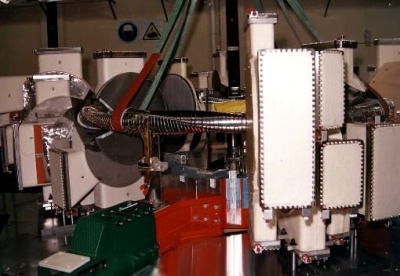TJ-II:Construction: Difference between revisions
No edit summary |
No edit summary |
||
| Line 1: | Line 1: | ||
[[File:TJ-II_Assembly.jpg|400px|thumb|right|A step in the assembly of TJ-II. The central conductor and parts of the [[TJ-II:Sectors|vacuum vessel]] with [[TJ-II:Ports|view ports]] are visible.]] | |||
[[TJ-II]] is a highly flexible medium-size fusion device of the Heliac type constructed at [[CIEMAT]] between 1991 and 1997. The [[TJ-II:Magnetic surface mapping|magnetic surface mapping]] was measured at low magnetic fields between December 1996 and January 1997, with excellent results. From January to September 1997 the commissioning of the device up to the design values was done, together with the assembly of the basic diagnostic equipment. | [[TJ-II]] is a highly flexible medium-size fusion device of the Heliac type constructed at [[CIEMAT]] between 1991 and 1997. The [[TJ-II:Magnetic surface mapping|magnetic surface mapping]] was measured at low magnetic fields between December 1996 and January 1997, with excellent results. From January to September 1997 the commissioning of the device up to the design values was done, together with the assembly of the basic diagnostic equipment. | ||
<ref>[http://dx.doi.org/10.1109/FUSION.1997.687032 M. Blaumoser et al, ''Construction, commissioning and first results of the Spanish Stellarator TJ-II'', Fusion Engineering, Proc. 17<sup>th</sup> IEEE/NPSS Symposium '''1''' (1997) 257 - 260]</ref> | <ref>[http://dx.doi.org/10.1109/FUSION.1997.687032 M. Blaumoser et al, ''Construction, commissioning and first results of the Spanish Stellarator TJ-II'', Fusion Engineering, Proc. 17<sup>th</sup> IEEE/NPSS Symposium '''1''' (1997) 257 - 260]</ref> | ||
Revision as of 08:59, 23 September 2009

TJ-II is a highly flexible medium-size fusion device of the Heliac type constructed at CIEMAT between 1991 and 1997. The magnetic surface mapping was measured at low magnetic fields between December 1996 and January 1997, with excellent results. From January to September 1997 the commissioning of the device up to the design values was done, together with the assembly of the basic diagnostic equipment. [1]
The all-metal vacuum vessel of TJ-II has a helical geometry and has 96 ports. Seven water-cooled copper coil systems with maximum currents between 7 kA and 32.5 kA provide the helical confinement field. The Bitter-type toroidal coils are split in half for assembly reasons. Four sets of poloidal coils produce the vertical, radial and OH fields.
TJ-II is a very compact experimental device with highly stressed materials and very narrow tolerances to achieve good confinement properties. This required high quality standards for the fabrication and assembly of the device. For the high precision positioning of all stellarator components, a computer-based theodolite system was employed. A large number of tests were done during the assembly phase. Afterwards a comprehensive commissioning program was performed.
The pulsed power supply was tested up to the maximum current values by means of a dummy load consisting of up to five inductively coupled coils. The distances between the coils were chosen in a way such that self and mutual inductances coincided with those of the coil systems of the stellarator, thus forming an electromagnetic image of TJ-II.